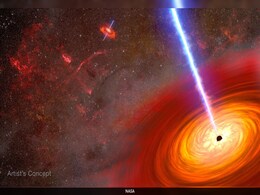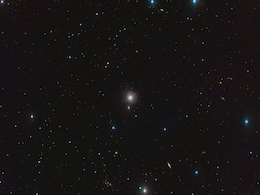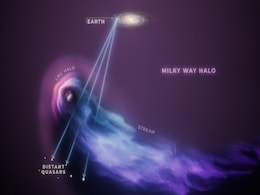Galaxy Collision
- All
- News
- Web Stories
-

Two Galaxy Clusters That Collided Previously Are All Set To Smash Again
- Saturday June 7, 2025
- Science | Edited by Abhinav Singh
Despite their enormous distance, the galaxy clusters are gravitationally bound and slowly turning back for another high-speed impact.
-
 www.ndtv.com
www.ndtv.com
-

Milky Way To Collide With Its Largest Neighbour Andromeda? What New Study Said
- Tuesday June 3, 2025
- World News | Edited by NDTV News Desk
Earlier, scientists believed the collision may destroy both galaxies, merging them into an elongated one.
-
 www.ndtv.com
www.ndtv.com
-

Milky Way May Not Be Destroyed In Galactic Smash-Up After All
- Monday June 2, 2025
- Science | Agence France-Presse
The Milky Way may not have a catastrophic collision with another huge galaxy as has been predicted, computer simulations revealed, giving our home galaxy a coin-flip chance of avoiding destruction.
-
 www.ndtv.com
www.ndtv.com
-

When Two Massive Black Holes Merged And Went Flying Across Cosmos
- Sunday March 9, 2025
- Science | Edited by Anjali Thakur
The researchers propose that this ejection resulted from the collision of two galaxies, causing their central black holes to merge into a larger one.
-
 www.ndtv.com
www.ndtv.com
-

Astronomers Spot Galaxy NGC 3640 With a Past of Consuming Smaller Galaxies
- Tuesday February 25, 2025
- Written by Gadgets 360 Staff
Recent observations of NGC 3640 reveal a history of merging with smaller galaxies. Located 88 million light-years away, the elliptical galaxy is suspected to be on a collision course with NGC 3641. The Very Large Telescope captured structural distortions, hinting at previous mergers. Researchers have identified ancient stars acting as fossil marker...
-
 www.gadgets360.com
www.gadgets360.com
-

Strange Fast Radio Bursts Emerge from an Ancient Dead Galaxy, Baffling Scientists
- Monday February 24, 2025
- Written by Gadgets 360 Staff
Scientists have detected mysterious fast radio bursts (FRBs) from the outskirts of an 11 billion-year-old dead galaxy. This discovery challenges the belief that FRBs primarily originate from young, star-forming galaxies. Researchers suspect the bursts may result from colliding stars or a collapsing white dwarf. The Canadian Hydrogen Intensity Mappi...
-
 www.gadgets360.com
www.gadgets360.com
-

NASA's Hubble and Chandra Telescopes Spot Strange Tilted Black Hole
- Tuesday December 24, 2024
- Written by Gadgets 360 Staff
NASA’s Hubble and Chandra telescopes have uncovered a bizarre sideways black hole in the galaxy NGC 5084, located 80 million light-years away. The black hole’s unexpected tilt suggests it may have been influenced by a violent galactic collision. A new image processing technique, SAUNAS, revealed X-ray plumes in the galaxy, hinting at a cosmic e...
-
 www.gadgets360.com
www.gadgets360.com
-

Hubble and Chandra Telescopes Spot Strange Tilted Black Hole in Galaxy NGC 5084
- Tuesday December 24, 2024
- Written by Gadgets 360 Staff
NASA’s Hubble and Chandra telescopes have uncovered a bizarre sideways black hole in the galaxy NGC 5084, located 80 million light-years away. The black hole’s unexpected tilt suggests it may have been influenced by a violent galactic collision. A new image processing technique, SAUNAS, revealed X-ray plumes in the galaxy, hinting at a cosmic e...
-
 www.gadgets360.com
www.gadgets360.com
-

Ancient Galaxy Collisions May Explain Formation of Massive Early Star Systems
- Monday December 9, 2024
- Written by Gadgets 360 Staff
Research published in Nature reveals that ancient galaxy collisions may have led to the creation of the universe’s largest star systems. Using data from the Atacama Large Millimeter/submillimeter Array (ALMA), scientists studied over 100 galaxies undergoing intense star formation. These collisions are believed to have occurred 8 to 12 billion yea...
-
 www.gadgets360.com
www.gadgets360.com
-

Distant Galaxies Crash to Produce Massive Sonic Boom, Could Reveal Secrets About the Universe: Report
- Tuesday November 26, 2024
- Written by Gadgets 360 Staff
The galaxy NGC 7318b has collided with its neighbours in Stephan’s Quintet, creating one of the most powerful shockwaves observed in space. The resulting debris, glowing plasma, and star formation are being studied using advanced spectrographic tools, offering rare insights into galaxy formation and evolution.
-
 www.gadgets360.com
www.gadgets360.com
-

Hubble Telescope Reveals Milky Way Blowing Gas off LMC Galaxy in Close Encounter
- Monday November 18, 2024
- Written by Gadgets 360 Staff
NASA’s Hubble Space Telescope has captured an extraordinary phenomenon as the Milky Way galaxy exerts ram pressure on the Large Magellanic Cloud (LMC), stripping away most of its gas halo. The interaction, which occurs as LMC passes near the Milky Way, has led to the loss of significant mass from the dwarf galaxy. Despite this, LMC retains enough...
-
 www.gadgets360.com
www.gadgets360.com
-

Hubble Telescope Captures Image of Merging Galaxies in Coma Cluster, 390 Million Light-Years Away
- Monday November 18, 2024
- Written by Gadgets 360 Staff
NASA and the European Space Agency (ESA) have shared an image of two galaxies, MCG+05-31-045, interacting within the Coma Cluster. Located 390 million light-years away, the pair is in the midst of a cosmic merger. As the smaller galaxy is pulled into the larger one, a new wave of star formation is expected. Over time, the galaxies will likely evolv...
-
 www.gadgets360.com
www.gadgets360.com
-

Supermassive Black Hole at the Centre of the Milky Way Is Spinning Unexpectedly
- Sunday September 15, 2024
- Written by Gadgets 360 Staff
Sagittarius A* (pronounced Sagittarius A Star), the supermassive black hole at the centre of the Milky Way, is spinning in an unusual way, and scientists now believe they may know why. Based on new data from the Event Horizon Telescope, researchers suggest that this cosmic giant likely merged with another black hole billions of years ago. This colo...
-
 www.gadgets360.com
www.gadgets360.com
-

Astronomers Spot Imminent Collision Of Supermassive Black Holes In Nearby Galaxy: Report
- Wednesday September 11, 2024
- Science | Edited by Nikhil Pandey
Astronomers have detected two closely spaced supermassive black holes in the galaxy MCG-03-34-64, located 800 million light-years away.
-
 www.ndtv.com
www.ndtv.com
-

Milky Way and Andromedia Fated Collision Might Not Happen, Reveals New Study
- Sunday August 25, 2024
- Gadgets 360 Staff
Recent research has cast doubt on the certainty of the Milky Way-Andromeda galaxy collision, suggesting the event may not be as inevitable as once thought. Traditionally, astronomers have predicted that our galaxy would merge with Andromeda within the next 5 billion years, creating a new elliptical galaxy often referred to as "Milkomeda." However, ...
-
 www.gadgets360.com
www.gadgets360.com
-

Two Galaxy Clusters That Collided Previously Are All Set To Smash Again
- Saturday June 7, 2025
- Science | Edited by Abhinav Singh
Despite their enormous distance, the galaxy clusters are gravitationally bound and slowly turning back for another high-speed impact.
-
 www.ndtv.com
www.ndtv.com
-

Milky Way To Collide With Its Largest Neighbour Andromeda? What New Study Said
- Tuesday June 3, 2025
- World News | Edited by NDTV News Desk
Earlier, scientists believed the collision may destroy both galaxies, merging them into an elongated one.
-
 www.ndtv.com
www.ndtv.com
-

Milky Way May Not Be Destroyed In Galactic Smash-Up After All
- Monday June 2, 2025
- Science | Agence France-Presse
The Milky Way may not have a catastrophic collision with another huge galaxy as has been predicted, computer simulations revealed, giving our home galaxy a coin-flip chance of avoiding destruction.
-
 www.ndtv.com
www.ndtv.com
-

When Two Massive Black Holes Merged And Went Flying Across Cosmos
- Sunday March 9, 2025
- Science | Edited by Anjali Thakur
The researchers propose that this ejection resulted from the collision of two galaxies, causing their central black holes to merge into a larger one.
-
 www.ndtv.com
www.ndtv.com
-

Astronomers Spot Galaxy NGC 3640 With a Past of Consuming Smaller Galaxies
- Tuesday February 25, 2025
- Written by Gadgets 360 Staff
Recent observations of NGC 3640 reveal a history of merging with smaller galaxies. Located 88 million light-years away, the elliptical galaxy is suspected to be on a collision course with NGC 3641. The Very Large Telescope captured structural distortions, hinting at previous mergers. Researchers have identified ancient stars acting as fossil marker...
-
 www.gadgets360.com
www.gadgets360.com
-

Strange Fast Radio Bursts Emerge from an Ancient Dead Galaxy, Baffling Scientists
- Monday February 24, 2025
- Written by Gadgets 360 Staff
Scientists have detected mysterious fast radio bursts (FRBs) from the outskirts of an 11 billion-year-old dead galaxy. This discovery challenges the belief that FRBs primarily originate from young, star-forming galaxies. Researchers suspect the bursts may result from colliding stars or a collapsing white dwarf. The Canadian Hydrogen Intensity Mappi...
-
 www.gadgets360.com
www.gadgets360.com
-

NASA's Hubble and Chandra Telescopes Spot Strange Tilted Black Hole
- Tuesday December 24, 2024
- Written by Gadgets 360 Staff
NASA’s Hubble and Chandra telescopes have uncovered a bizarre sideways black hole in the galaxy NGC 5084, located 80 million light-years away. The black hole’s unexpected tilt suggests it may have been influenced by a violent galactic collision. A new image processing technique, SAUNAS, revealed X-ray plumes in the galaxy, hinting at a cosmic e...
-
 www.gadgets360.com
www.gadgets360.com
-

Hubble and Chandra Telescopes Spot Strange Tilted Black Hole in Galaxy NGC 5084
- Tuesday December 24, 2024
- Written by Gadgets 360 Staff
NASA’s Hubble and Chandra telescopes have uncovered a bizarre sideways black hole in the galaxy NGC 5084, located 80 million light-years away. The black hole’s unexpected tilt suggests it may have been influenced by a violent galactic collision. A new image processing technique, SAUNAS, revealed X-ray plumes in the galaxy, hinting at a cosmic e...
-
 www.gadgets360.com
www.gadgets360.com
-

Ancient Galaxy Collisions May Explain Formation of Massive Early Star Systems
- Monday December 9, 2024
- Written by Gadgets 360 Staff
Research published in Nature reveals that ancient galaxy collisions may have led to the creation of the universe’s largest star systems. Using data from the Atacama Large Millimeter/submillimeter Array (ALMA), scientists studied over 100 galaxies undergoing intense star formation. These collisions are believed to have occurred 8 to 12 billion yea...
-
 www.gadgets360.com
www.gadgets360.com
-

Distant Galaxies Crash to Produce Massive Sonic Boom, Could Reveal Secrets About the Universe: Report
- Tuesday November 26, 2024
- Written by Gadgets 360 Staff
The galaxy NGC 7318b has collided with its neighbours in Stephan’s Quintet, creating one of the most powerful shockwaves observed in space. The resulting debris, glowing plasma, and star formation are being studied using advanced spectrographic tools, offering rare insights into galaxy formation and evolution.
-
 www.gadgets360.com
www.gadgets360.com
-

Hubble Telescope Reveals Milky Way Blowing Gas off LMC Galaxy in Close Encounter
- Monday November 18, 2024
- Written by Gadgets 360 Staff
NASA’s Hubble Space Telescope has captured an extraordinary phenomenon as the Milky Way galaxy exerts ram pressure on the Large Magellanic Cloud (LMC), stripping away most of its gas halo. The interaction, which occurs as LMC passes near the Milky Way, has led to the loss of significant mass from the dwarf galaxy. Despite this, LMC retains enough...
-
 www.gadgets360.com
www.gadgets360.com
-

Hubble Telescope Captures Image of Merging Galaxies in Coma Cluster, 390 Million Light-Years Away
- Monday November 18, 2024
- Written by Gadgets 360 Staff
NASA and the European Space Agency (ESA) have shared an image of two galaxies, MCG+05-31-045, interacting within the Coma Cluster. Located 390 million light-years away, the pair is in the midst of a cosmic merger. As the smaller galaxy is pulled into the larger one, a new wave of star formation is expected. Over time, the galaxies will likely evolv...
-
 www.gadgets360.com
www.gadgets360.com
-

Supermassive Black Hole at the Centre of the Milky Way Is Spinning Unexpectedly
- Sunday September 15, 2024
- Written by Gadgets 360 Staff
Sagittarius A* (pronounced Sagittarius A Star), the supermassive black hole at the centre of the Milky Way, is spinning in an unusual way, and scientists now believe they may know why. Based on new data from the Event Horizon Telescope, researchers suggest that this cosmic giant likely merged with another black hole billions of years ago. This colo...
-
 www.gadgets360.com
www.gadgets360.com
-

Astronomers Spot Imminent Collision Of Supermassive Black Holes In Nearby Galaxy: Report
- Wednesday September 11, 2024
- Science | Edited by Nikhil Pandey
Astronomers have detected two closely spaced supermassive black holes in the galaxy MCG-03-34-64, located 800 million light-years away.
-
 www.ndtv.com
www.ndtv.com
-

Milky Way and Andromedia Fated Collision Might Not Happen, Reveals New Study
- Sunday August 25, 2024
- Gadgets 360 Staff
Recent research has cast doubt on the certainty of the Milky Way-Andromeda galaxy collision, suggesting the event may not be as inevitable as once thought. Traditionally, astronomers have predicted that our galaxy would merge with Andromeda within the next 5 billion years, creating a new elliptical galaxy often referred to as "Milkomeda." However, ...
-
 www.gadgets360.com
www.gadgets360.com

















